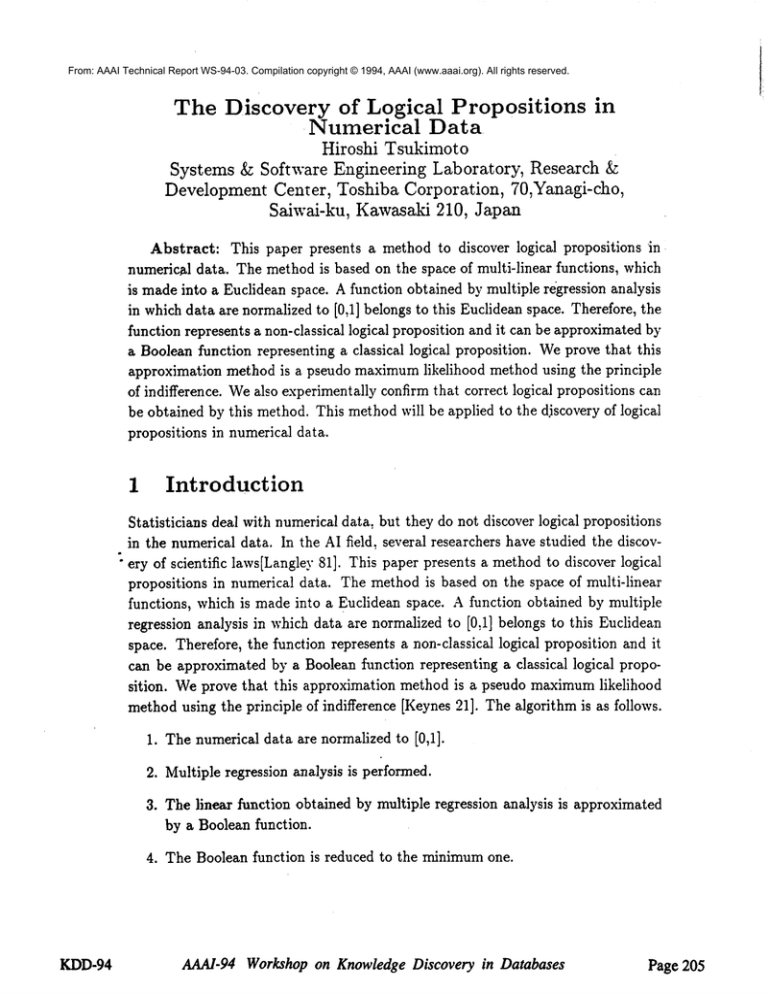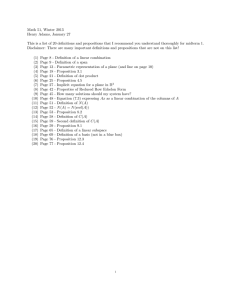
From: AAAI Technical Report WS-94-03. Compilation copyright © 1994, AAAI (www.aaai.org). All rights reserved.
The Discovery of Logical Propositions
¯ Numermal Data¯
in
Hiroshi Tsukimoto
Systems &: Software Engineering Laboratory, Research &
Development Cen~er, Toshiba Corporation, 70,Yanagi-cho,
Saiwai-ku, Kawasaki 210, Japan
Abstract: This paper presents a method to discover logical propositions in
numerical data. The method is based on the space of multi-linear functions, which
is madeinto a Euclidean space. A function obtained by multiple regression analysis
in which data are normalized to [0,1] belongs to this Euclidean space. Therefore, the
function represents a non-classical logical proposition and it can be approximatedby
a Boolean function representing a classical logical proposition. Weprove that this
approximation method is a pseudo maximumlikelihood method using the principle
of indifference. Wealso experimentally confirm that correct logical propositions can
be obtained by this method. This methodwill be applied to the d.iscovery of logical
propositions in numerical data.
1
Introduction
Statisticians deal with numerical data, but they do not discover logical propositions
in the numerical data. In the AI field, several researchers have studied the discovery of scientific laws[Langley 81]. This paper presents a methodto discover logical
propositions in numerical data. The method is based on the space of multi-linear
functions, which is madeinto a Euclidean space. A function obtained by multiple
regression analysis in which data are normalized to [0,1] belongs to this Euclidean
space. Therefore, the function represents a non-classical logical proposition and it
can be approximated by a Boolean ~unction representing a classical logical proposition. Weprove that this approximation method is a pseudo maximumlikelihood
methodusing the principle of indifference [Keynes 21]. The algorithm is as follows.
1. The numerical data are normalized to [0,1].
2. Multiple regression analysis is performed.
3. The linear function obtained by multiple regression analysis is approximated
by a Boolean function.
4. The Boolean function is reduced to the minimumone.
KDD-94
AAA1-94 Workshop on Knowledge Discovery in Databases
Page 205
Weexperimentally confirm that correct logical propositions can be obtained by
this method. This methodwill be applied to the discovery of logical propositions in
numerical data. Section 2 explains the space of multi-linear functions as an extended
modelfor logics. Section 3 explains the discovery of logical propositions in numerical
data.
Somereaders maythink that the problemin this paper is a classification problem
with continuous classes and the problem can be dealt with by some other algorithms
such as C4.5. However,C4.5 does not work well for the classification problem with
continuous classes [Quinlan 93].
2
Multi-linear
functions
A model for logics
Dueto the space limitation, we briefly explain an extended model for logics, where
logical functions including non-classical logical functions are represented as points
(vectors) in a Euclidean space. More detailed explanation including proofs can
found in [Tsukimoto94a]. Hereinafter, let F, G, ... stand for propositions, f, g, ...
stand for functions, X, Y, ... stand for propositional variables and x, y, ... stand for
variables.
2.1 Intuitive
explanation
Weexplain whya logical function is represented as a vector. It is worth noticing
" that classical logic has properties similar to a vector space. These properties are
seen in Boolean algebra with atoms which is a model for classical logic. Atomsin
Boolean algebra have the following properties:
a
1. ai.ai = ai (unitarity).
2. ai . aj - 0 (i # j) (orthogonality).
3. Eai = 1 (completeness).
For example, for the proposition 7;[ V Y = XY V ~;CY V ~’~, "X v Y is represented
(1,0,1,1),
where XY = (1,0,0,0),
XY= (0,1,0,0),
XY= (0,0,1,0),
(0, 0, 0,1). Atomsin Boolean algebra correspond to unit vectors. In other words,
atoms in Boolean algebra are similar to the orthonormal functions in a Euclidean
space.
This paper showsthat the space of logical functions actually becomesa Euclidean
space. The process from Boolean algebra to Euclidean space is divided into three
stages.
Page 206
AAA1-94 Workshop on Knowledse Discovery in Databases
KDD-94
1. Represent Boolean algebra by elementary algebra. In other words, present an
elementary algebra modelfor classical logic.
2. Expandthe domain from {0,1} to [0,1] and the model to the space of multilinear functions.
3. Introduce an inner product to the above space and construct a Euclidean space
where logical functions are represented as vectors.
2.2 An elementary
algebramodelfor classical
logic
2.2.1 Definitions
(1) Definition of
Let f(x) be a real polynomial function. Consider the following formula:
f(x) = p(z)(x - z~) +
where f : {0, 1} ---, R and q(x) = ax -+ b, where a and b are real. rz is defined as
follows:
r~: f(x) ~ q(x).
The above definition implies the following property:
= x.
In the case of n variables, r is defined as follows:
n
i=1
For example, r(x2y3 + y + 1) = xy + y q- 1.
(2) Definition of
Let L be the set of all functions satisfying r(f) = f. Then L = {f: r(f) =
In the case of twovariables, L = { azy -1- bx q- cy -{- d[a, b, c, d E R}.
(3) Definition of
L1 is inductively defined as follows:
1. Variables are in L1.
2. If f and g are in L1, then r(f.g), r(f g-/.g) and r( 1 - f) are in L 1. (We
call these three calculations r calculation.)
3. L1 consists of all functions finitely generated by the (repeated) use of 1. and
2.
KDD-94
AAAI-94 Workshop on Knowledge Discovery in Databases
Page 207
2.2.2
A new model for classical
logic
Let the correspondence between Boolean algebra and r calculation be as follows:
1. F A G ~ r(f g)
2. F v G c~ r(f + g- f g).
3. ]~ ¢~ r(1- f).
Then(LI, r calculation) is a modelfor classical logic; that is, L1 and r calculation
satisfy the axiomsfor Booleanalgebra. The proof is omitted due to space limitations.
Wegive a simple example. (X V Y) A (X V Y) = X V Y is calculated as follows:
_
r(X2 + y2 .q_ x2y: + 2xy -- 2x2y -- 2)
2xy
= x+y+xy+2xy--2xy--2xy
= x+y--xy.
2.3
Extension
of the model
First, the domainis extended to [0,1]. f : [0, 1]n --* R. By this extension, we have
continuously-valued logic functions, which satisfy all axiomsof classical logic. The
proof can be found in [Tsukimoto 94b]. Hereinafter, not only in the case of {0, 1},
: but also in the case of [0,1], the functions satis~,ing all axiomsof classical logic are
called Boolean functions.
The model is extended from L1 to L which was defined in 2.2.1. f : {0, 1}n ~ R
or f : [0, 1]’~ ~ R. L obviously includes Boolean functions and Linear functions. L
is called the space of multi-linear functions. In the case of {0, 1}, the space is the
sameas in [Linial 93]. Hereinafter, L will be madeinto a Euclidean space (a finite
dimensional inner product space).
2.4
Euclidean
space
2.4.1
Definition
of inner
product
and norm
In the case of [0,1], an inner product is defined as follows:
< f, g >= 2n r(fg)dx,
where f and g are in L, and the integral is generally a multiple integral.
In the case of {0,1}, an inner product is defined as
Page 208
AAAI-94 Workshop on Knowledge Discovery in Databases
KDD-94
< f,g >= ~’r(fg).
where this sum spans the whole domain. For example, in the case of two variables,
let f = f(x,y) and g = g(x,y), then f, g >=(r( fg))(1,1)+ (r(
/g))(1,O)+
(r(fg))(O, + (r(fg))(O, 0),
wher
e (r(fg))(1, 1) ithevalue of r(fg ) a t x = 1 a
y-1.
A norm is defined as
N(f) = ~/< f,f
L becomes an inner product space with the above norm. The dimension of this
space is finite, because L consists of the multi-linear functions of n variables, where
n is finite. Therefore, L becomesa finite dimensional inner product space, namely
a Euclidean space.
2.4.2
Orthonormal
system
The orthonormal system is as follows:
n
¢~ = II e(xj) (i = 1,...,2~,j
= 1,...,n),
j=l
where e(xj) = 1 - xj or xj.
It is easily understood that these orthonormal functions are the expansion of atoms
: in Booleanalgebra. In addition, it can easily be verified that the orthonormalsystem
satisfies the following properties:
<¢i,¢j>=
0(i # j),
l(i=j),
rl
2
f "- ~’~ < f,¢i > ¢i.
i=1
For example, the representation by orthonormal functions of x + y - zy of two
variables (dimension4) is as follows:
f = 1 .zy + 1.x(1 - y) + 1. (1- x)y +0. (1- x)(1 and the vector representation is (1, 1,1,0), wherethe bases are xy = (1, 0, 0, 0), z(1
y) = (0,1,0,0),(1 x) y = (0,0, 1, 0) an d (1 - x )( 1 - y ) = ( 0,0,0, 1). The
the functions of n variables is 2"-dimensional. The vector representation of Boolean
functions is the same as the representation expanded by atoms in Boolean algebra.
This vector representation is called a logical vector.
KDD-94
AAAI-94 Workshop on Knowledge Discovery in Databases
Page 209
3
Acquiring logical
propositions
from the functions obtained by multipleregression
analysis
3.1 The outline of the method
The method is to approximate the (multi-)linear functions by Boolean functions.
Approximating a linear function by a Boolean function means obtaining the nearest
Boolean function with respect to the Euclidean norm. Let (a/) be the logical vector
which represents the linear function obtained by multiple regression analysis. Let
(b~)(b~ = 0,1) be the logical vector which represents the nearest Boolean function.
The nearest Boolean function minimizes E(ai - bi) 2. Each term can be minimized
independently and bl = 1 or 0. Therefore, the approx~imation methodis as follows:
If a/_> 0.5, then b/= 1, otherwise b~ = 0.
For example, let z = 0.6x-1.1y+0.3 be obtained by multiple regression analysis.
The function is transformed to
z = -0.2xy + 0.9x(1 - y) - 0.8(1 x) y + 0. 3(1 - x)(1 that is, the logical vector is (-0.2, 0.9, -0.8, 0.3). By the above method,the logical
vector is approximatedto (0,1,0, 0), which represents .r(1 -y). Thus, 0.6x- 1.1 y+0.3
is approximated to x(1 - y), that is, X A
: 3.2 Pseudo maximumlikelihood
method
The approximation can be regarded as a pseudo ma.’dmumlikelihood method using
the principle of indifference [Keynes 21]. Ma~mum
likelihood method is explained
in manybooks, for example, [Wilks 62]. The principle of indifference says that a
probability distribution is uniform whenwe have no information.
3.2.1
A relation
between logic
and probability
The above approximation method is based on the norm of logical vectors, while
maximum
likelihood method is based on probability. The relation between the norm
of logical vectors madprobability must be studied. First, the amountof information
of a logical function H is defined as follows:
2,
H(f) = n- log2(N(f))
where n is the numberof variables. It can be verified that H is equal to I, which is
the amountof information of probability using the principle of indifference [Keynes
Page 210
AAAI.94 Workshop on Knowledge Discovery in Databases
KDD-94
21] in the case of classical logic, where I = n- H~,(He = -E~"pilog2pi)[Shannon
49]. The proof is omitted due to the space limitation. Wealso use this formula
in non-classical logics. The above formula is transformed to the one below, which
is used to prove that the approximation method is a pseudo maximumlikelihood
method.
N(])= 9.’/2
The proof is as follows:
H(f)
=
log2(N(f)) 2 = H,
(N(f)) 2 H,
= 2
N(f)
3.2.2
Pseudo
maximum likelihood
= H’/2.
method
Assumethat a logical vector f be near to a Boolean vector g, that is.
fi ~ gl, (i = 1,..., n)
The approximation is
[f - g[ ~ rain,
since fi " gi, (i = 1, ...,n),
the aboveformula is transformed to
Ilfl- Igll rain.
Since If[ and [g[ are 2H*/2 and 2H’/2 respectively from the discussion in the preceding
subsubsection, the formula is transformed to
[2H’/2 - 2H’/2[ ~ rain,
[H~- H~I ~ rain.
AssumeH’. > H~, then the formula is
H’~ - He ~ min.
KDD-94
AAAI-94 Workshop on Knowledge Discovery in Databases
Page 211
Since He = - F_,~"(pdog~pl) and H"t = - ~12"
(qJog2qi), the formula is
2a
2n
~_,(pitog:pi) ~-’~.( qilog2qi )-~rain.
1
1
Sincefi ~- gi, (i =1, ..., n), that is, pi ~- qi, (i -- 1, ..., n), anda logarithmicfunction
is rapidly descending in the domain[0,1], the formula is transformed to
2n
2"
(pdog,p,)(pdog
q,)-,rain.
I
I
This value is K-L(Kullback-Leib!er) information. Thus, the approximation method
has been proved to be a pseudo maximumlikelihood method.
3.3
Procedures
Hereinafter, multi-linear functions are limited to linear functions for simplification.
The procedures are as follows.
1. Normalizedata to [0,1].
There are a few methodsfor normalization. In this paper, we use the following
method:
Let a stand for the maximumdata and let b stand for the minimumdata.
y=(x-b)/(a-b),
where x is a given data and y is the normalized data.
2. Execute multiple regression analysis.
A linear function is obtained by the usual multiple regression analysis.
3. Orthonormal expansion
The linear function is expanded by the orthonormal functions.
4. Approximate it by a Boolean function.
A Boolean function is obtained by the approximation using the method in the
preceding subsection.
5. Transformit to a logical proposition.
The Boolean function is transformed to a logical proposition.
6. Reduce it to the minimumone.
The proposition is reduced to the minimumone.
Page 212
AAA1-94 Workshop on Knowledge Discovery in Databases
KDD-94
3.4
An example
Table 1 shows how a property of a metal depends on time and temperature.
1. Normalization
Table 1 is normalized to Table 2.
Table 1: A property of a metal
Sample number Temperature(X
Time(Y) Property(Z)
i
30
36
1
1700
39
2
1800
25
44
3
1800
20
44
4
1850
30
59
5
1900
10
51
6
1930
10
Table 2: A property of a metal (normalized)
Sample number Temperature(X) Time(Y
Property(Z)
1.00
0.000
1
0.000
0.435
0.75
0.130
2
0.435
0.50
0.348
3
4
0.652
1.00
0.348
5
0.87
0.00
1.000
1.000
0.00
0.652
6
2. Multiple regression analysis
z = 0.46x - 0.41y + 0.38 is obtained by multiple regression analysis.
3. Orthonormal expansion
The orthonormal expansion of the above function is
z = 0.46x-0.41y+0.38
KDD-94
= 0.43xy+O.S4x(1-y)-O.O3(1-x)y+O.38(1-x)(1-y).
AAAI-94Workshopon KnowledgeDiscoveryin Databases
Page213
4. Approximation
The following Boolean function is obtained by the approximation.
O.Oxy+ 1.0.r(1 - y) - 0.0(1 - x)y + 0.0(1 - x)(1
5. Logical proposition
A logical proposition X A Y is obtained.
6. Reduction
Reduction is not necessary in this case.
As a result, a proposition X A ~ has been obtained. If the domainis [0,1], this
proposition can be interpreted as " If temperature gets higher and time gets shorter,
the property gets higher." If the domainis {0, 1}, the proposition can be interpreted
as "If temperature is high and time is short, the property is high."
3.5
An experiment
Neural networks and someelectrical circuits consisting of nonlinear elements are the
examples whosestructure is logical or qualitative and only numerical data of which
are observed. Consider the following function:
w(z,y.z) = P((f(x) V ~(y)) h(z)),
where f(x),g(y)
and h(z) are as follows:
f(x) l(x _>
0.5), = o(x< 0.
g(u)=l(u > 0.6),=o(u<0.6),
h(z)=l(z >0.4),=O(z<0.4).
P(t) is a probabilistic function such that if t = 1, then P(t) is a value in [0.5, 1] and
if t - 0, then P(t) is a value in [0,0.5], where 0 < x, y, z, w < 1. Notice that the
threshold values of f, 9 and h are different.
The purpose of the experiment is to check if we can obtain the correct logical
proposition W= (X V ~) A Z) from some appropriate data. Let the data in
table below be given.
w = 0.2x - 0.2y + 0.4z + 0.2 is obtained by multiple regression analysis and the
orthononnal expansion is
0.6xyz + 0.2xy( 1 - z) + 0.8z( 1 - y)z + 0.4z( 1 - y)( 1 - z) + 0.4( 1 - x)y z
x)y(1 - z) + 0.6(1 - x)(1 y)z + 0.2(1 - x)(1 - y)(1 The nearest Boolean function is
Page 214
AAAI-94 Workshop on Knowledge Discovery in Databases
KDD-94
table 3: Ex )eriment
Z
W
X
Y
0.9 0.6 0.6 0..5
0.7 0.9 0.1 0.2
1.0 0.5 1.0 0.7
0.6 0.5 0.2 0.3
1.Oxyz + O.Oxy(1- z) + 1.0x(1 y)z + O.Ox(1 - y)(1 - z)+ 0. 0(1 - x)yz + 0.0(1 x)y(1 - z) + 1.0(1 - x)(1 y)z + 0.0(1 - x)(1 - y)(1 The following proposition is obtained.
XYZ V X~Z V XYZ = (X v T) ^
Nowwe have the correct logical proposition, which cannot be seen in the given
numerical data and the linear function obtained by multiple regression analysis.
Whetherthe correct logical proposition can be obtained or not depends on the data
and the logical proposition. That is, if the correct logical proposition is "complicated", it cannot be obtained due to the roughness of multiple regression analysis
using linear functions and if the given numerical data are "wrong", the correct logical proposition cannot be obtained. If morecorrect results are desired, multi-linear
functions of a higher order ( For example, in the case of two variables, a second
order multi-linear function can be represented as axy + bx + cy + d.) should be used
for multiple regression analysis.
3.6
Error
analysis
In the case of the domain{0, 1}, Linial showedthe following result [Linial 93]:
Assumethat the probability distribution is the uniform distribution. Let f be a
Boolean function, there exists a k-multi-linear function g such that II f - g t1< e,
where k is at most O(tog(n/e)2), where n is the numberof variables.
This theorem means that Boolean functions can be well approximated by a multilinear function of low order. Wecan conjecture that this property also holds in the
domain[0,1], which will be included in future work.
KDD-94
AAAI-94 Workshop on Knowledge Discovery in Databases
Page 215
4
Conclusions
This paper has presented a method to discover logical propositions in numerical
data. The method is based on the space of multi-linear functions, which is made
into a Euclidean space. A function obtained by multiple regression analysis in
which data are normalized to [0,1] belongs to this Euclidean space. Therefore. the
function represents a non-classical logical proposition and it can be approximated
by a Boolean function representing a classical logical proposition. Wehave proved
that this approximation method is a pseudo maximumlikelihood method using the
principle of indifference. Wealso have experimentally confirmed that correct logical
propositions can be obtained by this method. This method will be applied to the
discovery of logical propositions in numerical data.
References
[Keynes 21]
J.M. Keynes: A Treatise on Probability, Macmillan, London, 1921.
[Langley 81]
P. Langley, G. Bradshaw and H.A. Simon: BACON.5:Thediscovery of conservation laws, Proceedings of the Secenth International
Joint Conferenceon Artificial Intelligence, pp.121-126, 1981.
[Linial 93]
N. Linial, Y. Mansour and N. Nisan: Constant depth circuits.
Fourier Transform, and Learnability, Journal of the A CM,Vol.40.
No.3, pp.607-620, 1993.
[Quinlan 93]
J.R.. Quinlan: Programsfor ,VIachine Learning, MorganKaufmann.
1993.
[Shannon 49]
C.E. Shannon and W. Weaver: The Mathematical Theory of Communication, Univ. III. Press, 1949.
[Tsukimoto 94a] H. Tsukimoto and C. Morita: The Discovery of Propositions in
Noisy Data, Machine Intelligence 13, Oxford University Press,
1994.
[Tsukimoto 94b] H. Tsukimoto: On Continuously Valued Logical Functions Satisfying All Axiomsof Classical Logic, Transactions of The Institute of
Electronics, Information and CommunicationEngineers, Vol.J771)-1 No.3, pp.247-252, 1994 (in Japanese).
[Wilks 62]
Page 216
S.S. Wilks: Mathematical Statistics,
John Wiley & Sons, 1962.
AAAI.94 Workshop on Knowledge Discovery in Databases
KDD-94








